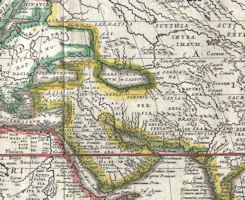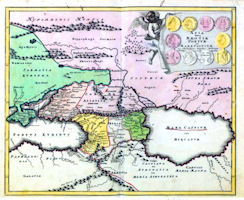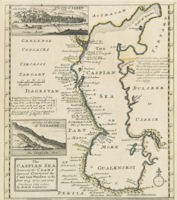Caspian Sea
Though the presidents of Azerbaijan, Iran, Kazakhstan, Russia, and Turkmenistan attended the Caspian Sea summit in Aqtau, and signed a joint document dividing the sea on 12 August 2018. The major undecided problem was how to satisfactorily divide the maritime borders of Azerbaijan and Turkmenistan with Iran. Iranian President Hassan Rohani said at the summit that more talks were needed on the Caspian borders, although previous agreements signed between Azerbaijan, Russia, and Kazakhstan -- and jointly by Turkmenistan and Kazakhstan -- resolved those countries' border issues long before the Aqtau summit. Rohani's comments meant that for the near future, Azerbaijan and Turkmenistan probably will not be able to develop hydrocarbon fields in the area of the Caspian that lies near the as-yet undefined border with Iran -- at least not without consulting with and likely including Iran in any projects there.
As regards construction of the long-planned Trans-Caspian Pipeline (TCP), which aims to bring some 30 billion cubic meters of gas from Turkmenistan to Azerbaijan and ultimately to Europe, the Caspian Convention signed on August 12 states that "Parties may lay submarine cables and pipelines on the bed of the Caspian Sea." The document also gives neighboring states the right to conclude bilateral agreements on pipelines that would run along the seabed exclusively through their territorial waters, meaning legally there should be no problem for Azerbaijan and Turkmenistan to construct the TCP, especially since the area where the pipeline would be laid is well north of any potential maritime border with Iran.
For more than two decades, disputes have held up many important projects, notably energy export initiatives such as the proposed Trans-Caspian Pipeline from Turkmenistan to Azerbaijan that would ideally bring Turkmen gas to European markets. While the division of the Caspian in the north of the Caspian Sea was completely painless, in the relations between Turkmenistan and Azerbaijan the conflict over the offshore fields "Azeri" and "Shirag" was very painful. Not everything developed in the relations between Iran and Azerbaijan.
Beginning in the early 1990s, the United States sought to develop Central Asia�s energy resources and transport them to global markets. In the 1990s, the target was Europe, with plans for oil and gas pipelines across the Caspian Sea to Azerbaijan, and thence through Georgia and Turkey to Europe.
In July 2001, the first and so far the last armed incident between the two neighboring Caspian countries occurred in the Caspian Sea. Iranian warships prevented the implementation of the project of an international consortium led by British Petroleum to develop promising structures Alov, Araz and Sharg located in the southern part of the Caspian Sea near the maritime border of Azerbaijan and Iran.
On December 5, 2017, Russian Foreign Minister Sergei Lavrov announced that all the key issues regarding the delimitation of the Caspian Sea had been resolved. On 12 August 2018 in the Kazakh city of Aktau, located on the coast of the Caspian Sea, the summit of the heads of the Caspian countries (Russia, Azerbaijan, Iran, Kazakhstan and Turkmenistan) took place. As expected, it not only discussed the issues of cooperation and security, but also signed the Convention on the Legal Status of the Caspian Sea. Over this document, representatives of the five countries had worked for more than 20 years.
The legal regime of the Caspian Sea was established by the Treaty between the RSFSR and Persia on February 26, 1921 and the Treaty on Trade and Navigation between the USSR and Iran of March 25, 1940. In the Soviet-Iranian treaties the basis was the principle of "common water", which provided for freedom of navigation and fishing for the Caspian states (with the exception of the 10-mile fishing zone), the prohibition of vessels sailing under the flags of non-Caspian countries. At the same time, the contracts did not regulate subsoil use, environmental protection and military activities.
The disintegration of the Soviet Union gave rise to a new situation in the Caspian. Iran demanded to divide the shelf equally - 20 percent per each Caspian player. Uusing the middle modified line [equidistant from the coast line and taking into account the length of the coastline] would leave Iran with the smallest sector of about 11 percent. Naturally, this approach did not suit the other Caspian states. The new COnvetiona transferred responsibility for the division from the five-sided discussion to the bilateral level, as was the case when the northern part of the sea was divided.
If the Caspian were designated under international law as a lake, then all five littoral states would equally share all the resources and revenue from those resources, and any one state could veto other governments� projects. This is what Iran has wanted. But if the signatories designated the Caspian as a sea, then each state would map out its territorial waters and exploit those resources as they saw fit.
Under the new convention, all the countries around the Caspian Sea would have the right to lay any pipelines and cables without the consent of their neighbours, but with the necessary notification about the routes taken. This meant that after signing and ratifying the convention, Turkmenistan would be able to start looking for partners for the construction of the Trans-Caspian Gas Pipeline.
The issue of militarization of the Caspian Sea was debated, like everything related to this water basin, for more than twenty years. Russia has its own Caspian flotilla, which gained wide popularity after being struck with ship missiles by detachments of Syrian Islamists - only about 70 combat and auxiliary vessels. Iran has its own Caspian fleet - about 90 ships, mostly small missile boats, there is also a destroyer, and construction of small submarines has begun. Kazakhstan has 4 rocket-artillery ships that make up its coastal guard. Azerbaijan, after the division of the Caspian Flotilla of the USSR, received 30 percent of its floating base (a patrol boat, a missile boat, two artillery boats, a patrol boat, five minesweepers, four amphibious ships and other boats). The fleet of Turkmenistan is two missile boats, and minesweepers.
All the Caspian countries emphasize the need to preserve the peaceful nature of the Caspian basin, noting that their naval forces are aimed at combating the terrorist threat, protecting the borders, etc. Thus, outwardly all sides demonstrate the desire for a peaceful Caspian. At the same time, they are trying to protect oilfields, pipelines, and tankers. The same aspirations are shown also by "external players", the Americans.
The Caspian Sea is the habitat for more than 90 % of the sturgeon in the world and up to 90% of the world's black caviar comes from the Caspian region. Russia, Kazakhstan, Azerbaijan, Turkmenistan, and Iran all border the Caspian and catch various species of sturgeons for their flesh and caviar, however in recent years over-fishing has threatened the species to the point that environmentalists advocate a total ban on sturgeon fishing until the reserves replenish.
Measured by surface area, the Caspian Sea is the world�s largest inland water body. It covers roughly 371,000 square kilometers (143,200 square miles) and borders five countries. To the ancient Greeks and Persians, the lake�s immense size suggested it was an ocean, hence its name. The color of the Caspian Sea darkens from north to south, thanks to changes lake in depth and perhaps sediment and other runoff. The northern part of the lake is just 5 to 6 meters (16 to 20 feet) deep. The southern end, however, plunges more than 1,000 meters (3,300 feet).
Just as the lake reaches a greater depth in the south, the nearby land reaches a greater height. The mountains of northern Iran line the southern end of the giant lake, and emerald green vegetation clings to those mountain slopes. In marked contrast to the mountains, sand seas line the southeastern and northern perimeters of the lake, and marshes occur along the lake shores in Azerbaijan to the west.
Gas hydrates are solid substances similar to ice, but consist of molecules of hydrocarbon gas (mostly methane) enclosed in cages of water molecules. The gas hydrates form under conditions of high pressure and low temperature, where there is a sufficient supply of gas and water. Association of gas hydrates with mud volcanoes enhance the chances of offshore explosive eruptions.
Mud volcanoes mostly occur in sedimentary environments in relations to the presence of subsurface pressurized ?uids. The gas phase (often represented by methane) is the most important in driving the ascent of subsurface mud/fluid mix and variably sized rock fragments. Extrusion of this material yields the development of a number of scenic morphological features, of which the conical-shaped mud volcanoes represent the most typical outcome. Mud volcanoes may vary greatly in size, from less than 1 meter to the gigantic submarine �Conical Seamounts�.
The South Caspian Sea has been known for centuries to be affected by natural hazards, including explosive eruptions of mud volcanoes, as attested in historical documents. The Azerbaijan mud volcanoes distinguish for their remarkable dimensions, as well as for the impressive eruptions they may experience occasionally. There are more mud volcanoes in Azerbaijan than anywhere else in the world � about 350 of 800 mud volcanoes on the planet are in this country. They are located not far from Baku. Presumably, the first eruptions here took place 25 million years ago. It is known that since 1810 in Azerbaijan there were about 200 eruptions from 50 volcanoes. The association of gas hydrates with active mud volcanoes in the South Caspian Sea increases the potential for offshore flaming eruptions.
Multiple rivers empty into the Caspian Sea, the Volga being the largest. The Volga River, Europe's longest and largest river by volume, flows from northwest Russia into the Caspian Sea. Lacking an outlet, the Caspian Sea loses water only by evaporation, leading to the accumulation of salt. Although a lake, the Caspian is not a freshwater lake; the water delivered by the Volga River minimizes the lake�s salt content at the northern end, but the Caspian grows more saline to the south. Kara-Bogaz-Gol is a saline inlet along the lake�s eastern perimeter.
Geological research indicates that the Caspian Sea was once part of a prehistoric sea known as the Paratethys. Tectonic forces uplifting the land and a drop in sea level left the Caspian landlocked more than 5 million years ago. Climate shifts have alternately raised and lowered the lake�s water levels, sometimes nearly drying it out completely.
Being a closed basin, the Caspian Sea in its waterbody has to accumulate all the dissolved and suspended components discharged by the river runoff. During the current century because of anthropogenic pollution the river waters and their solid loads are enriched with heavy metals, organic and non-organic chemicals and in addition, since the 1950s, with technogenic radionuclides which came with fallout and river discharge from nuclear industries and nuclear power stations located in the river basins. Oil and its products are also substantial component of the sea pollutants especially since the last decades when the process of exploration and exploitation of new oil fields has intensified.
The Caspian Sea region, which includes Russia, Azerbaijan, Kazakhstan, Turkmenistan, Uzbekistan, and Iran, is one of the oldest oil-producing areas in the world and is an increasingly important source of global energy production. The area has significant oil and natural gas reserves from both offshore deposits in the Caspian Sea itself and onshore fields in the region. Traditionally an oil-producing area, the Caspian area's importance as a natural gas producer is growing quickly.
Not long after oil was first produced in Baku in the late 19th century, pipelines were recognized as the most efficient means of transport from the Caspian Sea to world markets. The next hundred-plus years saw extensive pipeline construction, particularly with Russian-controlled networks serving Russia, Europe, the Balkans, and elsewhere. A second rush began in the 1990s for Caspian's oil and gas reserves. Where Russia and Iran had once been the only countries bordering the Caspian Sea, they were now joined by Azerbaijan, Kazakhstan, and Turkmenistan. Each had its own energy supply, its own national interests, and in some instances its own pipeline preferences.
Azerbaijan and Kazakhstan contain proved gas reserves of approximately 2.6 trillion cubic meters. Turkmenistan and Uzbekistan hold twice this amount. This is an impressive and valuable resource base. EIA estimates that there were 48 billion barrels of oil and 292 trillion cubic feet (Tcf) of natural gas in proved and probable reserves within the basins that make up the Caspian Sea and surrounding area in 2012. Offshore fields account for 41% of total Caspian crude oil and lease condensate (19.6 billion barrels) and 36% of natural gas (106 Tcf). In general, most of the offshore oil reserves are in the northern part of the Caspian Sea, while most of the offshore natural gas reserves are in the southern part of the Caspian Sea.
In addition, the U.S. Geological Survey (USGS) estimates another 20 billion barrels of oil and 243 Tcf of natural gas in as yet undiscovered, technically recoverable resources. Much of this is located in the South Caspian Basin, where territorial disputes over offshore waters hinder exploration.
EIA estimates that the Caspian Sea region produced an average of 2.6 million barrels per day of crude oil and lease condensate in 2012, around 3.4% of the total world supply. Over the past decade, Kazakhstan's onshore oil fields, particularly the Tengiz field, were the biggest contributor to the region's production. As Azerbaijan developed the Azeri-Chirag-Guneshli (ACG) field group between 2006 and 2008, its offshore production began accounting for an increasing part of total Caspian production. Other significant sources of Caspian oil include production in Turkmenistan near the coast and in Russia's North Caucasus region.








